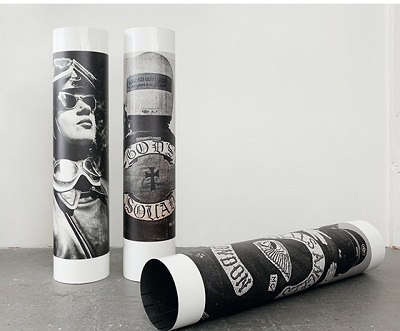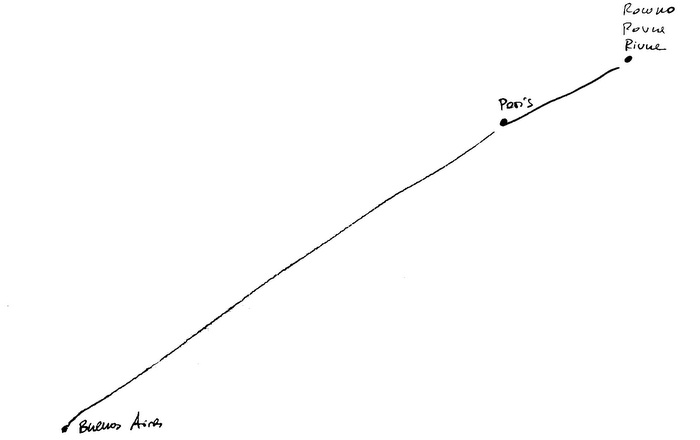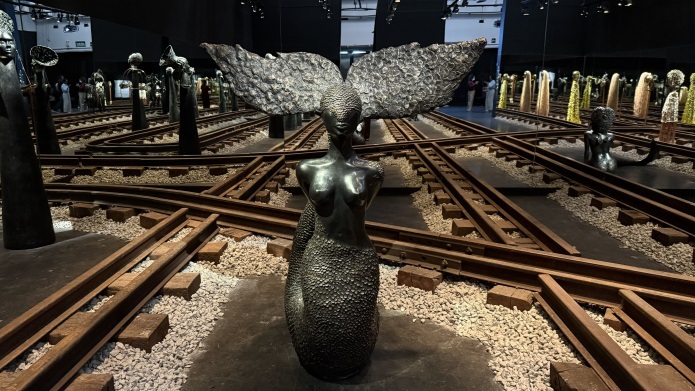For its first year at the fair Triple V has invited French artist Servane Mary to exhibit a solo show on its stand. The gallery’s booth will be an immersive experience of the artist’s work as she will cover the walls with perforated hardboard - a material generally used in craft shops to display tools or products. Each wall will feature a unique silkscreened image created especially for the fair.
In addition, there are three other works that will be displayed. These pieces are part of an ongoing series that feature enlarged photos of women riding motorbikes that have been printed directly on metal or on enamel painted steel. The specific works shown at the fair are printed on enamel painted steel cylinders which create the illusion of a three dimensional image. The warped material of the piece suggests that there is a reverse-side of the image and that it is possible to access its other side or depth.
The steel cylinders change the appearance of the image in a way that is reminiscent of a rotary printing press, a device that generated a unique way at looking at the world through its grid like frames that were used to create magazines and newspapers. The perspective of the works are staged accordingly to this reference.
Servane Mary works with reclaimed press images of women from the 1940s through the 1970s. Several of the depicted women are her personal heroes; others are viewed as anti-heroes; misunderstood, misrepresented, tragic figures. This act of “re-figuration” through art explores the connection between representation, identity, history and memory in the way Servane Mary treats the photographs as physical entities.
These photos reveal traces of the passage of time in their faded deterioration in a way that parallels our own recollection and mind. The images are transferred onto various materials that encourage the viewer to re-evaluate the subjects and reconsider the idea of a static position and one’s place in the world.
In addition to metals, Servane Mary often uses recycled materials such as cotton, silk veils, safety blankets, mirrors or paper to print her images. She uses these materials due to their associations with the female body – scarves, veils, hosiery, leggings, negligees etc. The end result gives a “second skin” to images of the “second sex.”
The artist’s frequent use of reflective surfaces incorporates the image of the viewer into the work and draws them into a piece even more. In acknowledging her own questions and thoughts, Servane Mary positions herself in direct relation to an image and the lens through which it is focused - only to be distorted and reconstructed herself just as the art.
Servane Mary considers the image to be just as important a material as its supports. The presentation of the images in this form is the artist’s interpretation of viewer engagement and inclusion that leads to reflections on sculptural, sociological, and political ideas while addressing a collective history. The period referenced (from the 1940s into the 1970s) is particularly poignant as the roles and identities of women in the society were being redefined. The self-image of women is a continuously evolving process which endures to this day.
Triple V gallery’s most recent show at its 500 square metres space at 5, rue du mail, Paris close to place des Victoires, was a solo exhibition of Servane Mary last September.
Servane Mary
Franco-Swiss artist Servane Mary, born in 1972, studied at the Ecole Nationale Supérieure des Arts Décoratifs and then the Ecole des Beaux-Arts, Atelier de la Glacière, both in Paris. Now living in New York her work has been successful on both sides of the Atlantic.
Her fascination with vintage and iconic photography, led her to reproduce the images in a large format onto Perspex, either with silkscreen or inkjet printing, transforming it into sculpture. The appropriated images Servane Mary uses cover the themes of society, politics, gender and power.















